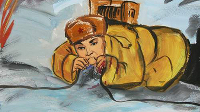The Glove Box
What follows is an essay which I wrote in a fit of rage at the state of current computer technology roughly a year ago. It is entirely unpolished, unedited, and probably contains quite a few words and concepts meaningful only to myself. I originally had no intention of ever making it public, but after reading this post I could no longer resist the urge to do so.
The printed word is an excellent presentation medium but a rather shoddy expression medium. Linearizing a thought necessarily destroys structural information. Unfortunately today's technology does not allow us to share our thoughts with others save by running them through the meatgrinder of linearization and textual representation. This, however, need not always remain the case.
IA, or Intelligence Amplification [insert graphic of Dilbertesque cube drone balancing Einstein-esque figure complete with chalkboard on a "justice scale"] is AI's shriveled mutant sibling, hidden away whenever there is the slightest chance of polite company appearing for the evening. The usual argument used to dismiss the contemporary computer as a vehicle of IA is bandwidth limitations. We flesh sacks are, supposedly, incapable of communicating our flesh bag thoughts quickly or unambiguously enough to satisfy a machine in real time, or at least to the degree required for a functional equivalent to a bona fide brain upgrade.
We struggle with keyboards and mice, both of which solve the wrong problem. The latter being "how do we encode visual representations of neolithic speech patterns?" The real problem is: how do we arrive at the canonical representation of a concept, in all of its stages of life - from conception, with all the infinite vagueness this entails, to a ball of conceptual clay, infinitely malleable, to a solidified whole suitable for use as a building block for further thought.
There is no bandwidth problem inherent to the human body and brain. All that must be done is to simply adapt the same sort of Huffman-like coding that forms the basis of all language to the communication between man and machine - in the most general possible form.
The key concepts involved in designing the ultimate and most general form of information manipulator are:
1) the "magic glove box" and 2) the Huffmanator
The glove box, for the lack of a better name, aims to utilize the two keenest senses possessed by mankind: vision and motor/tactile (hands, fingers - motion, touch. temperature?) Your arms and hands fit through two openings in what appears to be an ordinary glove box of the type found in biological laboratories. Unlike the latter, your first sensation is as though the box is full of warm water. You can rest your arms and hands without discomfort. Your seat is configured in such a way that you can sustain such an idle position indefinitely, again without discomfort. You could even fall asleep if you wish.
The first illusion is the transparency of the glove box. Although you can see your arms and hands, you are not actually looking through a glass sheet. You are, in fact, looking at a high-resolution color display. There is also no water inside of the box; nor is it filled with any other fluid. Your appendages are, in fact, resting on thin air, supported by arm-length gloves assembled from (ferrofluid? muscle wire?) microcells that can shift in position, stiffness, angle, temperature. Your sense of touch - humanity's strongest ally in its toolmaking shenanigans throughout history - is your guide. As are your eyes. But the normal physical limitations no longer apply. The box switches into demo mode and displays M. C. Escher's famous paradoxical staircase. You feel the staircase with your fingers, and it is actually there! You are holding, touching a - physically impossible object. And all of the sensations are correct, exactly as though our universe actually allowed the staircase to exist as drawn - no, more than as drawn; as implied by the drawing, in the same fashion as the Klein bottle is merely implied by the meager picture we are able to draw in three-space.
With the glove box you are able to touch anything you can see, with no limits imposed by the bothersome geometry of our universe. Now what remains is to gain the ability to see - and record, and manipulate - anything you can think, anything you can imagine. There must be no thought that you are not able - within seconds at most - to place inside the box, at your slightest whim. If you picture a Platonic sphere, it will appear. If you want to deform it, or turn it into (what you remember of) a hemoglobin molecule, you can also do that. How could such a thing be possible? It is very easy. All one needs to do is to exploit the basic idea behind all language: compression. We already have a direction to travel in: the world's sign languages will show us the way.
Sign languages replace the spoken word with hand gestures. The degrees of motile freedom of each hand/arm/finger joint multiplied with the others combined with real-time visual and tactile feedback from the glove box gives you the hands and eyes of a god. Now all that remains is to create a self-consistent universe for the newly minted god to play with. This is our next objective.
The first task is to descibe the outermost magisterium of thought. The concept of "concept". Gather your fingers in the box, as though you saw a planar surface - an angled glasss table? inside. Angle your fingers, bunched together, as though you intended to place them on the glass. You see the glass. There is no telepathy - the machine simpy matched the anticipatory motions of your fingers with those recorded from humans who are reaching out to touch just such a glass table - and an idealized representation of it has been drawn before your fingers hit the virtual surface. You feel the glass, smooth and cool to the touch - the 0,5mm^2 peltier pixels on the inside of the gloves are doing a bang-up job. Your next act is to dig your fingertips into the middle of the glass, as though you saw a very small hole there and wanted to enlarge it. The glass spreads like modeling clay - except, the entire infinite plane does so at once. The physical limitations of real glass (or any other material) hold no power here. As you tear spacetime open, you contemplate what you should fill the void with. You curl your left hand into the form of a ball; your right hand curls into the shape it would be in if it were placing such a ball on top of an infinite sea of melted wax. You can feel the ball of your left hand in your right. You let go of the phantom ball with your right hand, and it drops - a new one taking its place a second later. You arrange the atoms in 3-space. The glove box supports your arms and hands in any position you may want to leave them in - gravity is irrelevant. A single pedal under your feet (think Singer sewing machine) adjusts your ability to see through solids. With the aid of these tools, you create simple subunits (as we just saw, a chem textbook style "atom"), place them in arbitrary locations in 3-space. Now you want to save them for future reference and use as building blocks. This is where the Huffanator comes in. In much the same manner as you created the shapes, you can also create concepts.
There is no need to type words, or represent ideas in textual form. A sphere appears whenever you want one, and so can an 1895-vintage dynamo - the only difference is a dozen or so conceptual links which you compose as easily as you composed the hemoglobin from the "rock paper scissors" shapes your hands started with. Your hands, with the feedback from the glove box, are all-powerful. You can lay them on any object - any piece of information, in fact - that you can imagine. Your fingertips slide over the prime numbers. The prickly stubble of the Riemann zeta function bristles against your skin. A flick of your wrist sends the entire universe, crumpled, like a fast food wrapper, tumbling into the void (actually, into permanent memory, but that's beside the point.) As for the compression, that part is obvious. The machine learns the meaning of your most minute motions through frequency analysis - The Gold Bug - and attaches meanings to them. You provide it with nonstop confirmation or refutation of these meanings as you work. And the machine becomes you, and you it.
-------------------------------------------------
How to build the Glove Box
----------------------------
One possibility is a fractal structure with the Stewart platform as the basic unit: larger ones for macro-scale movements, and vanishingly small ones for submillimeter tactile feedback.
... to be continued.



w00t.